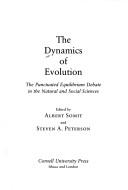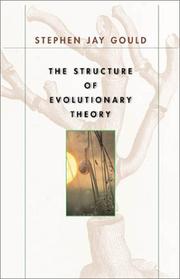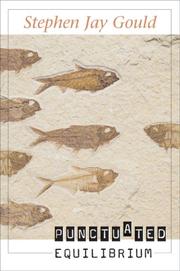| Listing 1 - 6 of 6 |
Sort by
|

ISBN: 080142531X 0801497639 Year: 1992 Publisher: Ithaca (N.Y.) : Cornell university press,
Abstract | Keywords | Export | Availability | Bookmark
 Loading...
Loading...Choose an application
- Reference Manager
- EndNote
- RefWorks (Direct export to RefWorks)
Evolution. --- Human evolution. --- Punctuated equilibrium (Evolution). --- Social evolution. --- Sociobiology.

ISBN: 0674006135 9780674006133 Year: 2002 Publisher: Cambridge (Mass.) : Belknap press of Harvard university press,
Abstract | Keywords | Export | Availability | Bookmark
 Loading...
Loading...Choose an application
- Reference Manager
- EndNote
- RefWorks (Direct export to RefWorks)
Evolution (Biology) --- Punctuated equilibrium (Evolution) --- Evolution (Biology). --- Punctuated equilibrium (Evolution). --- Evolution. Phylogeny --- 575.8 --- Equilibrium, Punctuated (Evolution) --- Punctuated equilibria (Evolution) --- Punctuationalism (Evolution) --- Animal evolution --- Animals --- Biological evolution --- Darwinism --- Evolutionary biology --- Evolutionary science --- Origin of species --- Biology --- Evolution --- Biological fitness --- Homoplasy --- Natural selection --- Phylogeny --- 575.8 Evolution. Origin of species. Phylogeny --- Evolution. Origin of species. Phylogeny --- Acqui 2006 --- EVOLUTION --- PHILOSOPHY AND SCIENCE --- THEORY

ISBN: 0674037847 9780674037847 9780674024441 0674024443 Year: 2007 Publisher: Cambridge, Mass. Belknap Press of Harvard University Press
Abstract | Keywords | Export | Availability | Bookmark
 Loading...
Loading...Choose an application
- Reference Manager
- EndNote
- RefWorks (Direct export to RefWorks)
'Punctuated Equilibrium' offers Stephen Jay Gould's book-length testament on an idea he fiercely promoted, repeatedly refined, and tirelessly defended.
Punctuated equilibrium (Evolution) --- Evolution (Biology) --- Animal evolution --- Animals --- Biological evolution --- Darwinism --- Evolutionary biology --- Evolutionary science --- Origin of species --- Biology --- Evolution --- Biological fitness --- Homoplasy --- Natural selection --- Phylogeny --- Equilibrium, Punctuated (Evolution) --- Punctuated equilibria (Evolution) --- Punctuationalism (Evolution)
Book
ISBN: 0231153171 023152675X 9780231526753 9780231153164 0231153163 9780231153171 Year: 2015 Publisher: New York
Abstract | Keywords | Export | Availability | Bookmark
 Loading...
Loading...Choose an application
- Reference Manager
- EndNote
- RefWorks (Direct export to RefWorks)
All organisms and species are transitory, yet life endures. The origin, extinction, and evolution of species-interconnected in the web of life as "eternal ephemera"-are the concern of evolutionary biology. In this riveting work, renowned paleontologist Niles Eldredge follows leading thinkers as they have wrestled for more than two hundred years with the eternal skein of life composed of ephemeral beings, revitalizing evolutionary science with their own, more resilient findings. Eldredge begins in France with the naturalist Jean-Baptiste Lamarck, who in 1801 first framed the overarching question about the emergence of new species. The Italian geologist Giambattista Brocchi followed, bringing in geology and paleontology to expand the question. In 1825, at the University of Edinburgh, Robert Grant and Robert Jameson introduced the astounding ideas formulated by Lamarck and Brocchi to a young medical student named Charles Darwin. Who can doubt that Darwin left for his voyage on the Beagle in 1831 filled with thoughts about these daring new explanations for the "transmutation" of species. Eldredge revisits Darwin's early insights into evolution in South America and his later synthesis of knowledge into a theory of the origin of species. He then considers the ideas of more recent evolutionary thinkers, such as George Gaylord Simpson, Ernst Mayr, and Theodosius Dobzhansky, as well as the young and brash Niles Eldredge and Steven Jay Gould, who set science afire with their concept of punctuated equilibria. Filled with insights into evolutionary biology and told with a rich affection for the scientific arena, this book celebrates the organic, vital relationship between scientific thinking and its subjects.
Punctuated equilibrium (Evolution) --- Evolution (Biology) --- Emergence (Philosophy) --- Emergent evolution (Philosophy) --- Emergent laws (Philosophy) --- Emergent philosophy --- Emergent properties (Philosophy) --- Emergent structure (Philosophy) --- Emergentism (Philosophy) --- Philosophy --- Complexity (Philosophy) --- Evolution --- Equilibrium, Punctuated (Evolution) --- Punctuated equilibria (Evolution) --- Punctuationalism (Evolution) --- Philosophy. --- Darwin, Charles,
Book
ISBN: 2070766810 9782070766819 Year: 2006 Volume: *6 Publisher: Paris: Gallimard,
Abstract | Keywords | Export | Availability | Bookmark
 Loading...
Loading...Choose an application
- Reference Manager
- EndNote
- RefWorks (Direct export to RefWorks)
En 1972, Stephen Jay Gould bouleversa l'orthodoxie darwinienne - autrement appelée la «théorie synthétique de l'évolution». Il formulait la théorie de l'équilibre ponctué: le changement, au cours des temps géologiques, ne s'était pas fait de manière graduelle, comme l'avait soutenu Darwin, mais par des phases de stabilité suivies de phases de changement rapides, permettant l'apparition de nouvelles espèces. Cette thèse, largement confirmée aujourd'hui, a conduit S. J. Gould à réexaminer la théorie darwinienne et à la repenser profondément. L'ouvrage, fruit de ce travail de réflexion et de conceptualisation, est le livre fondateur d'une nouvelle théorie de l'évolution, à partir d'un élargissement du darwinisme.
Evolution (Biology) --- Punctuated equilibrium (Evolution) --- Adaptation (Biology) --- Evolution (Biologie) --- Equilibres ponctués, Théorie des (Evolution) --- Adaptation (Biologie) --- evolutietheorie (darwinisme) --- théorie de l'évolution (darwinisme) --- Equilibres ponctués, Théorie des (Evolution) --- Évolutionnisme. --- Ponctualisme --- Évolution (biologie) --- Darwinisme --- Équilibres ponctués --- Adaptation (biologie) --- Ponctualisme. --- Darwinisme.

ISBN: 0674417933 0674417925 9780674417922 0674006135 9780674006133 9780674417939 Year: 2002 Publisher: Cambridge, Mass.
Abstract | Keywords | Export | Availability | Bookmark
 Loading...
Loading...Choose an application
- Reference Manager
- EndNote
- RefWorks (Direct export to RefWorks)
The world’s most revered and eloquent interpreter of evolutionary ideas offers here a work of explanatory force unprecedented in our time—a landmark publication, both for its historical sweep and for its scientific vision. With characteristic attention to detail, Stephen Jay Gould first describes the content and discusses the history and origins of the three core commitments of classical Darwinism: that natural selection works on organisms, not genes or species; that it is almost exclusively the mechanism of adaptive evolutionary change; and that these changes are incremental, not drastic. Next, he examines the three critiques that currently challenge this classic Darwinian edifice: that selection operates on multiple levels, from the gene to the group; that evolution proceeds by a variety of mechanisms, not just natural selection; and that causes operating at broader scales, including catastrophes, have figured prominently in the course of evolution. Then, in a stunning tour de force that will likely stimulate discussion and debate for decades, Gould proposes his own system for integrating these classical commitments and contemporary critiques into a new structure of evolutionary thought. In 2001 the Library of Congress named Stephen Jay Gould one of America’s eighty-three Living Legends—people who embody the “quintessentially American ideal of individual creativity, conviction, dedication, and exuberance.” Each of these qualities finds full expression in this peerless work, the likes of which the scientific world has not seen—and may not see again—for well over a century.
Evolution (Biology) --- Punctuated equilibrium (Evolution) --- Equilibrium, Punctuated (Evolution) --- Punctuated equilibria (Evolution) --- Punctuationalism (Evolution) --- Animal evolution --- Animals --- Biological evolution --- Darwinism --- Evolutionary biology --- Evolutionary science --- Origin of species --- Biology --- Evolution --- Biological fitness --- Homoplasy --- Natural selection --- Phylogeny --- adaptation. --- anagenesis. --- competition. --- divergence. --- fossil record. --- genetics. --- germinal. --- hierarchical selection. --- homology. --- inheritance. --- lamarckism. --- mass extinction. --- micro v macroevolution. --- modern synthesis. --- neo darwinism. --- origin of species. --- paleontology. --- punctuated equilibrium. --- speciation. --- variation.
| Listing 1 - 6 of 6 |
Sort by
|

 Search
Search Feedback
Feedback About
About Help
Help News
News